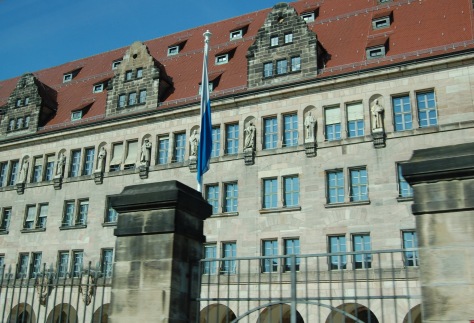As you know, when travelling in Germany we lived by a very important rule: Fawlty’s Law, which states, “Just don’t mention the war.”
In Nuremberg, this rule doesn’t seem to apply, as the locals bring it up first and then expect some discussion and head nodding to follow.
The Nazi party, under Adolf Hitler, had a very mesmerising and radicalising impact on Germans in the 1930’s, something that they never want to see again. Anywhere. The ridiculousness of Hitler’s ambitions, as communicated at the Nuremberg Rallies, for the Third Reich to have a 1000 year reign, was exemplified by the scale of the facilities he had built there. The Rally Grounds cover 11 square kilometres! A massive arena was partially completed until the war coffers began to run dry.

The stadium from outside…

…inside…

…and what it was planned to be.

The focal point for Hitler to address the masses at the Rally Grounds
After the war, the Nuremberg city rulers were incredibly embarrassed and ashamed by the role their city had played in the rise of the Nazi Party and Adolf Hitler. They started to destroy and remove some of the iconic structures and, dare I say, religious pillars and statues associated with the hypnotic power of the Nazi regime. But then they stopped. The new generation of Germans, and those opposed to the former Party, fought to keep the remaining buildings as a lesson to the world, never to repeat the evil that rose in their city.
The war trials were also held here. These saw the conviction of 22, and execution of 12, Nazis of war crimes and crimes against humanity.

The Court House still contains working courts. They were in use so we couldn’t visit.
The city was extensively damaged by Allied bombing, yet the rebuild remained faithful to the mainly baroque style so that it still looks old. The castle also sustained damage but has been faithfully restored. Only when our tour guide pointed out the newer stone work was it apparent. Incredible work!

The moat was always dry

Entry to the will age was via this tunnel. If you were unfriendly, expect boiling oil and sewerage poured down on to you through the holes!

The original stoned have bullet like holes in the side from being carried and positioned by clamping tongs

The tower served as lookout and final bastion of safety.see the bricked in arched doorway halfway up on the left? Once in there the ladder was pulled in too.
It is a beautiful city. Like so many places we visited, a couple of nights rather than an afternoon would have been ideal.

The greater city from the walled old city

Saturday markets in the old city square

The Shöner Brunner Fountain from the 14th century











